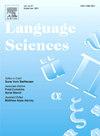Feeding the imagination: Linguistic features of motion descriptions in audio-described movies
IF 1.1
2区 文学
Q2 EDUCATION & EDUCATIONAL RESEARCH
引用次数: 0
Abstract
Audio description is a mode of audiovisual translation which renders visual information, including action, accessible to the visually impaired. Because languages differ in their typical means for describing motion events (i.e. Talmy 1985; Slobin 1996a), the audio-described experience available to speakers of different languages may likewise differ, a phenomenon we have dubbed ‘thinking-for-audio-describing’ (cf. thinking-for-speaking, Slobin 1996a). This study examines information about motion events given in the German and Spanish audio-described versions of a corpus of movies aimed at children and young adults. Like English, German typically encodes information about manner in the main verb, thus providing a good contrast to Spanish, which more typically encodes information about path. The results indicate that manner-of-motion information is more varied and frequent in German audio descriptions than in Spanish ones. We argue that this is due to the combined impact of the describer's mother tongue and of the restrictions and guidelines for audio description, with the result that users of audio descriptions in different languages may be presented with different experiences of the same work.
丰富想象力:有声电影中动作描述的语言特征
音频描述是一种视听翻译方式,它使视障人士能够获得包括动作在内的视觉信息。因为语言在描述运动事件的典型方式上有所不同(例如Talmy 1985;Slobin 1996a),不同语言的人所获得的听觉描述经验也可能不同,我们将这种现象称为“为听觉描述而思考”(参见thinking-for-speaking, Slobin 1996a)。本研究考察了针对儿童和青少年的电影语料库的德语和西班牙语音频描述版本中关于运动事件的信息。与英语一样,德语通常在主动词中编码有关方式的信息,因此与西班牙语形成了很好的对比,西班牙语更典型地编码有关路径的信息。结果表明,德语音频描述中的动作方式信息比西班牙语音频描述中的动作方式信息更加多样化和频繁。我们认为,这是由于描述者的母语和音频描述的限制和指导方针的综合影响,结果是不同语言的音频描述用户可能会对同一件作品有不同的体验。
本文章由计算机程序翻译,如有差异,请以英文原文为准。
求助全文
约1分钟内获得全文
求助全文
来源期刊

Language Sciences
Multiple-
CiteScore
2.90
自引率
0.00%
发文量
38
期刊介绍:
Language Sciences is a forum for debate, conducted so as to be of interest to the widest possible audience, on conceptual and theoretical issues in the various branches of general linguistics. The journal is also concerned with bringing to linguists attention current thinking about language within disciplines other than linguistics itself; relevant contributions from anthropologists, philosophers, psychologists and sociologists, among others, will be warmly received. In addition, the Editor is particularly keen to encourage the submission of essays on topics in the history and philosophy of language studies, and review articles discussing the import of significant recent works on language and linguistics.
 求助内容:
求助内容: 应助结果提醒方式:
应助结果提醒方式:


